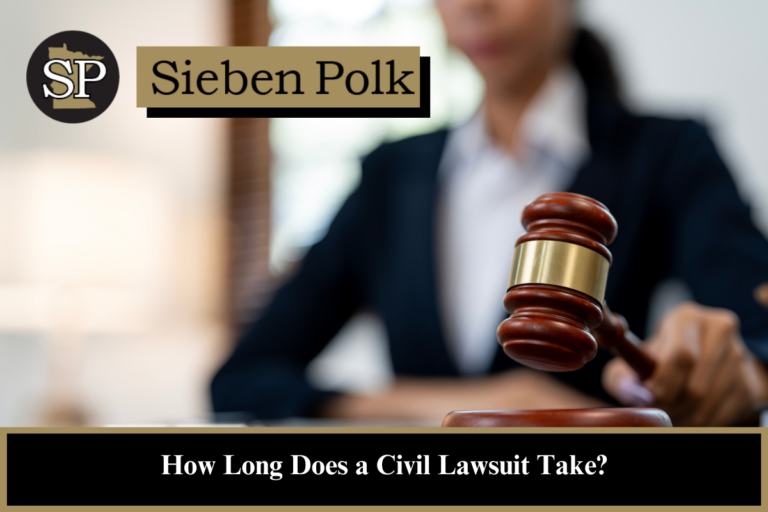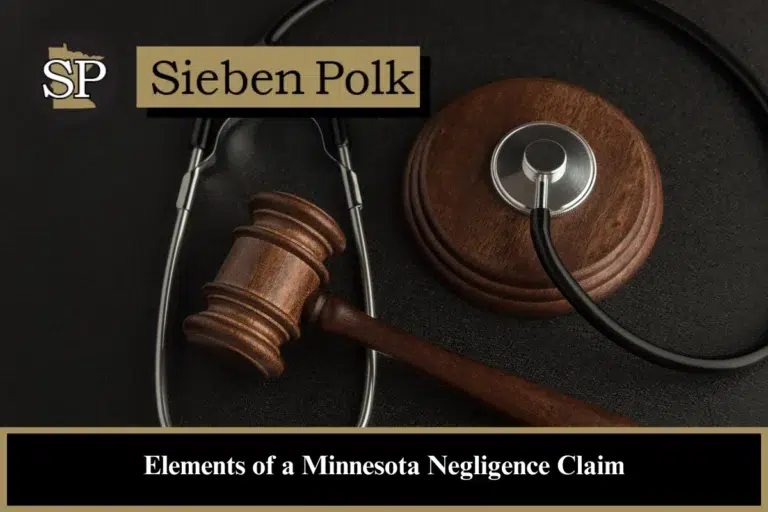Understanding the timeline for a civil lawsuit in Minnesota is essential for anyone involved in a legal dispute. The duration of a civil lawsuit can vary significantly depending on case complexity, the number of parties involved, and how the case progresses through the legal system.
It is advisable to consult a Minnesota injury attorney to understand the potential duration of your claim.
Navigate This Page
- What Are the Key Factors That Affect the Duration of a Civil Lawsuit in Minnesota?
- Typical Timeline for a Civil Lawsuit in Minnesota
- How to Speed Up Your Civil Lawsuit or Dispute
- What Are Common Factors That Cause Delays in Civil Cases?
- How Can Sieben Polk P.A. Help You With Your Civil Lawsuit?
- Contact Sieben Polk P.A. for a Free Consultation
- Related Reading:
What Are the Key Factors That Affect the Duration of a Civil Lawsuit in Minnesota?
Civil lawsuits in Minnesota can take anywhere from several months to several years to resolve. The main factors that influence the duration include:
- The complexity of the case
- The number of parties involved
- How cooperative the parties are
- The nature and scope of the investigation
- Whether the case requires appeals or goes to trial
Typical Timeline for a Civil Lawsuit in Minnesota
While each case is unique, most civil lawsuits in Minnesota follow a general structure. Below is an overview of the key stages and typical timelines for each:
Pre-Lawsuit Stage (1 Week to Several Months)
During this initial phase, parties investigate facts, review documents, and attempt to negotiate a resolution. Straightforward cases may resolve quickly, while more complex ones can take months.
Pleading Stage (1 to 2 Months)
Once the pre-lawsuit phase concludes, the plaintiff will serve the defendant with a summons and complaint, formally starting the lawsuit.
Disclosure and Discovery (1 to 6 Months)
This stage involves the exchange of information, including documents, interrogatories, and depositions. It can last anywhere from a few weeks to several months depending on case complexity.
Motion Stage (1 to 3 Months)
At this stage, formal requests are made to the court for rulings or judgments. For instance, a motion for summary judgment could potentially resolve parts of the case without a trial.
Pretrial Stage (Approximately 1 Month)
In preparation for trial, the parties file motions and requests. A trial management or settlement conference may be scheduled to explore a resolution before proceeding to trial.
Trial and Decision (1 Day to 3 Months)
The trial itself can last from a single day to several weeks, depending on the case’s complexity. Post-trial motions can further extend the timeline.
Appeal (6 Months to Over 1 Year)
If either party decides to appeal the court’s decision, the process can take several months to over a year, especially if the case moves to the Minnesota Court of Appeals or Supreme Court.
Post-Judgment (1 Month to Several Years)
After a judgment is rendered, collecting the judgment can take from a few weeks to several years, especially if the losing party is uncooperative.
How to Speed Up Your Civil Lawsuit or Dispute
Certain steps can help expedite the civil litigation process in Minnesota:
- Consult a lawyer as soon as possible
- Narrow the scope of the trial
- Maintain open communication throughout the case
- Explore alternative dispute resolution methods such as mediation or arbitration
- Respond promptly to requests, pleadings, and discovery
- Keep thorough records and gather supporting evidence
- Develop a legal strategy and consider negotiation options
What Are Common Factors That Cause Delays in Civil Cases?
Several factors can lengthen the timeline of a civil lawsuit:
- Unclear laws or contested facts
- Excessive evidence to review
- Delays caused by uncooperative parties or witnesses
- Changes in legal representation
- Refusal to consider settlement options
How Can Sieben Polk P.A. Help You With Your Civil Lawsuit?
At Sieben Polk P.A., our experienced attorneys understand the complexities of civil litigation in Minnesota. We can help streamline the process, meet all deadlines, and advocate for your interests.
Contact Sieben Polk P.A. for a Free Consultation
For assistance with your civil dispute or lawsuit, contact Sieben Polk P.A. today. Call (651) 437-3148 or fill out our online form to schedule a free consultation with an experienced Minnesota personal injury attorney.




